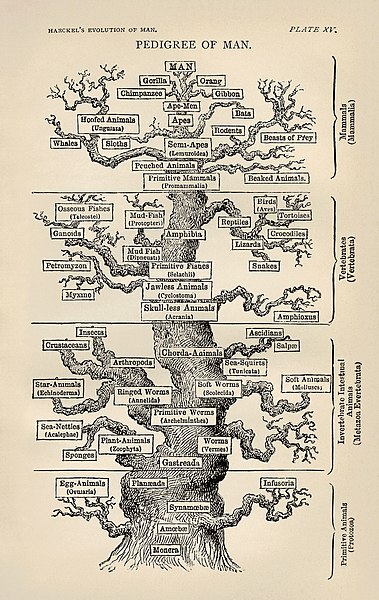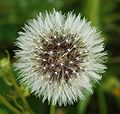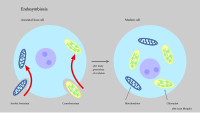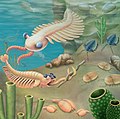Wikijunior:Biology/Printable version
| This is the print version of Wikijunior:Biology You won't see this message or any elements not part of the book's content when you print or preview this page. |
Wikijunior
Biology
Wikimedia-Book for Chidren

Written by
The Volunteers and Editors at
Wikibooks.org
A Wikimedia Foundation Project
Table of contents
Introduction
Biology is the study of life. It helps us understand many things, such as how our body works, how our body keeps warm, and what we are made of. Biology is very important to know. Some things we can learn about in biology are genetics (the study of human traits), zoology (the study of animals), botany (the study of plants), and ecology (the study of relationships between all living things).
Someone who studies biology is called a biologist.
-
genetics
-
zoology
-
botany
-
ecology
What is life?
Living things are different from things that are not alive. It is usually easy to tell what is living and what is not, but it is sometimes hard to tell, like with very small organisms.
Here are some properties of living things. You might notice that some non-living things can also have some of these properties.
- Living things can change and grow. However, volcanoes can also change and grow when they erupt.
- Living things can move. However, the wind is moving air, and water always moves downhill.
- Just like animals, even plants can move. They can grow, and sometimes move more rapidly than that, in response to things such as the sun or water. One example is that sunflowers will naturally turn during the course of the day so that they are always facing the sun. Similarly, another example is that if a plant gets tipped over, it will want to turn upwards to face the sun.
- Living things can reproduce, which means that they can produce copies of themselves, over and over. This is the most important difference between living and non-living things.
- In order to reproduce, living things need nutrition, which are nutrients and energy sources in order to assemble the materials needed to reproduce themselves. In this process, living things must excrete waste. Waste is material which is of no use to living things, or in some cases, material that can be harmful.
Animals, bacteria, and plants are examples of living things. Rivers, mountains, oceans, and soil are examples of non-living things, but they are often homes for living things.
Cars and tables are also not living things, because they cannot reproduce themselves.
-
Freshwater Alga
-
Berry
-
Dragon-fly
-
Fern
-
Turtle
-
Bloom
Levels of life
Living things can be of many different sizes. Size is very important in biology, since biologists organize the structures and groupings of living creatures according to size. A living creature is called an organism. Organisms can consist of single cells or multiple different types of cells grouped into tissues and organs.
From smallest to largest, these are how living things are grouped:
- Cells
- Most cells are only a few microns wide, and are so small that they can only be seen with a microscope. A micron is one thousandth of a millimeter.
- Tissues
- Tissues are groups of similar cells that are all doing similar things, like a muscle, which pulls things together.
- Organs
- Organs are made of lots of tissues. They all have a special function, like the heart, which pumps blood.
- Organ systems
- Organ systems are groups of organs which work together to do something. For example, all the organs which digest your food make up the digestive system.
- Organisms
- An organism is a whole living thing, like you, or a tree.
- Populations
- A population is a group of organisms which are all the same species and live together.
- Communities
- A community is a group of populations of different species, which live together; for example, all the fish in a lake.
- Ecosystems
- All the communities of organisms in an area, and the way they interact with non-living things like rivers or the weather in that area, form an ecosystem.
- Biomes
- A biome is a large region of Earth that has a certain climate and certain types of living things. Major biomes include tundra, forests, grasslands, and deserts.
- Biosphere
- The biosphere is the whole network of living things on planet Earth — eight thousand miles in diameter, twenty five thousand miles around the equator.
Everything in this list is made up of the things above it. For example, communities are made of many populations and populations are made up of many organisms.
 |
| The earth, our home, our biotope in space. |
Creatures
Many different creatures live on earth: plants, insects, birds, fish, bacteria, humans and many more. They have many differences and similarities.
-
Monkey
-
Pterois volitans
-
Marabou Stork
-
Jelly Monterey
-
Common carder bee
-
Euglena
Are living beings related to each other?
According to the theory of evolution, all living beings on earth are related to each other.
We humans are therefore related to monkeys, cows and apple trees, but also to mosquitoes and bacteria. All living organisms on earth today share common ancestors.
Tree of life
-
Tree of life by Haeckel
-
Circular timetree-of-life 2009
In 1879, the biologist Ernst Haeckel drew a family tree of living things inspired by the family trees of noble families. At the roots are the unicellular organisms, from which all higher living beings descend, with humans at the top. Scientists are aware that scientific statements can be wrong and therefore look for errors. They found errors in Haeckel's picture. So, the birds are drawn in the wrong place.
Modern family trees are much more complex. Humans are now on a par with other living organisms. On the left of the picture are the mammals, next to them are the birds. One of the lines denotes the humans. Extinct creatures such as dinosaurs are not shown here. Even the modern family trees are probably wrong. Viruses can transfer genes between different organisms and protozoa can exchange genes with other protozoa. There are many unanswered questions, especially in the case of unicellular organisms. There is still much to explore for future biologists.
Science and theory of evolution
The aim of science is to understand the world better (knowledge) and to produce new technology (innovation). Scientists develop mental models (theories) and functional models (such as an engine). Then they test these models through thought and experimentation. Appropriate models are presented to the public. Scientists change these models and test them again. For scientists, models are not the truth. They are therefore always looking for improvements. Good theories are understandable and thoroughly tested.
-
Cucurbita maxima
-
Cucurbita pepo Acchini
-
Cucurbita pepo
-
Cucurbita pepo 'Ufo'
-
Assorted Cucurbita pepo
-
Cucurbita from Bayern
Development of the theory of evolution
For centuries, scientists have repeatedly suspected that today's creatures had common ancestors. They knew that breeders of crops and livestock can change the characteristics of living beings. So, the pumpkin growers used only the seeds of the best pumpkins for the next seed. In some regions, growers propagated red gourds, in other regions green ones. This is how different shapes came about. However, the scientists could not explain how breeding without a breeder could work.
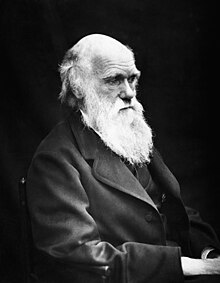
Charles Darwin recognized that natural selection is possible without a breeder. For example, if the food is encased in a thick shell, a bird must be able to crack it to survive. A thick beak makes this possible. The problems in the habitat of living beings determines the goals. A narrow-pointed beak helps to capture insects. He realized this through observations on a trip to the Galapagos Islands.
-
Darwin's finches
Evolution as natural selection

The genes are located in the cells of living beings. The genes contain the building and operating instructions of the living being. These are made up of DNA.
- Mutation
DNA can be altered by naturally occurring radioactive radiation. This leads to changes in the offspring. As a result, children, such as Darwin finch chicks, have different characteristics. They are called variations.
- Selection
Some chicks die, others survive. Creatures that are better adapted to the environment have a better chance of surviving. Chicks with a feeding beak are more likely to survive.
- Propagation
The survivors can have children.
Evolution as a scientific process

Evolution and scientific work are based on a comparable process:
- Mutation
Science: Scientists modify existing models.
Evolution: Radiation changes DNA.
- Selection
Science: Scientists test the models in experiments.
Evolution: The realities of nature are a severe test for all living beings.
- Propagation
Science: Through a publication, other scientists learn about the model.
Evolution: Living beings have children.
The theory of evolution describes a scientific knowledge and innovation process. Evolution produces innovations and insights
Direction and destination
A breeder strives for goals, the evolutionary process of nature does not. But the mechanism of evolution has one direction: best possible adaptation to the environment in order to survive. For example, being able to fly is very useful. Many innovations were needed before the physical and mental abilities were available for birds to fly and find their way back home after a migration.
Science and truth
In philosophy, there have been arguments about truth for centuries. Since each side was convinced that they had the (absolute) truth at their disposal, an agreement was impossible. Science has solved the problem: on the one hand, science dispenses with absolute statements. All statements are preliminary and can always be improved. On the other hand, scientists have developed methods to check the quality of models. Scientific statements are not true or untrue, but of high or low quality. That doesn't mean scientists aren't confident in their theories. However, good scientists are generally willing to revise their own convictions.
Is the theory of evolution a good theory?
- The theory of evolution is understandable. It is clear that well-adapted creatures are more likely to survive.
- The theory of evolution is logical. It is based on the laws of mathematics (statistics).
- The theory of evolution is often tested. It has been verified by computer simulations, experiments and observations in nature.
- The theory of evolution is helpful. It explains many properties of living things and processes in nature that would otherwise be incomprehensible.
The theory of evolution is a high-quality theory.
In particular, questions of speciation, the Cambrian Explosion and the origin of life are currently under discussion.
Definition of Life
Scientists have come up with over a hundred different definitions of the term "life". Many definitions are similar. They usually belong to one of five categories.
Definitions
- Enumeration of properties
Life is a system that has a metabolism, can grow, multiply and move as well as change through mutation.
Definitions should help to avoid misunderstandings when working together. Scientists have therefore developed quality criteria for definitions.
With enumerations, a problem arises with classification if not all criteria are met. Enumerated definitions are of low quality.
-
Metabolism
-
Growth Rings
-
Seeds
-
Racing Automobile
-
Tulip with Mutation
- Matter and Energy
Life is a system of nucleic acids and polymerases that absorbs and processes substances and energy.
The definition is limited. It relates to earthly life.
Some scientists suspect that there are life forms in space that use other substances.
-
RNA Polymerase
- Information
Life is a system that can absorb, process and deliver information and controls itself.
The definition is wide. It does not separate biology from technology.
-
Information
- Themodynamics
Life is an unstable system that creates and maintains order within itself.
This definition applies to other aspects of life: Living beings try to maintain order so they don't die.
That's true, but definitions are meant to be intuitive.
-
Entropie
The definitions listed distinguish between animate and inanimate.
In the following symbiosis-based definition, there is a graded transition. Organisms are a higher life form than unicellular organisms because they rely on more symbioses.
- Scientifically - philosophically
Life is based on symbioses, ie on cooperation for mutual benefit. Philosophical: Life is based on the principle of love.
Principle-based definitions are of higher quality than adhock definitions.
This is a principle-based definition: symbioses form the basis of life. But biologists have different opinions on this question.
The symbiosis definition gives life an (ethical) value, which is important for doctors and lawyers. But many biologists strictly reject the use of philosophical terms like "love".
-
Clownfish with Sea anemone
-
African buffalo with cattle egret
-
Hummingbird with Plant
-
Crocodile with Plover
-
Ant with Aphid
-
Lichen: Mushroom with Algae
Life is diverse. Each of these definitions illuminates different aspects of life.
Origin of Life
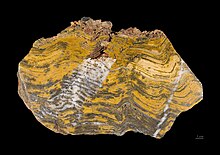
About a billion years after the formation of the earth, there were protozoa and stromatolite. It is not known how life evolved. There are various theories, one of which is presented below. Living things control their internal chemistry. A main problem in the transition from chemistry to biology is self-regulation. A comparison with the market economy should clarify this.
- When the warehouses in a factory are full, production is stopped. (End products inhibit chemical reactions.) In a market economy, production is regulated by supply and demand. (In chemistry, starting products and end products control the reaction.)
- There is a problem with waste products in the industry. These must be disposed of. This reduces the profit. Many entrepreneurs have become rich because they came up with an idea of how to make something valuable out of the waste products. The waste product became the raw material. (The end product of one chemical reaction can become the starting product of another reaction.)
* Step 1: Cycle
Starting products and catalysts promote chemical reactions. After the reaction, the catalysts are released and are available for further reactions. That's why it's called a cycle. End products inhibit chemical reactions.
* Step 2: Hypercycle The end product of a chemical reaction becomes the starting product in another reaction. This restarts the production of this substance.
Both cycles control and sustain each other in a symbiosis.
The metabolic processes of every cell are based on a large number of hypercycles. According to the symbiosis-based definition, hypercycles are very simple life forms based on chemistry, single-celled organisms with their enormous number of hypercycles are a significantly higher life form.
Living things need a boundary to hold their parts together. It is possible that the first living beings arose in small cavities in the rock between which chemical substances circulated. It was only much later that individual cells left the cavities and settled elsewhere. The first form of life was therefore not a single cell, but a habitat. The first biological form of life was therefore the biotope.
Living beings need to constantly take in food. This consists of chemicals and provide building material and energy. In order for life to arise, the necessary chemical substances such as sugar, fats and amino acids had to be available. Scientists have shown that for all important substances there are a number of ways in which they could have formed. A number of biologists therefore believe that there are living beings on many planets and moons in space.
Speciation
All living things live in a shared environment. They need to use certain things (called resources) from their environment, like food, water, and a place to live. These resources are limited, so when more than one organism tries to use the same resource, they end up in competition. When two living things compete for a common resource, one of them will eventually win and consume (or use) that resource. When something about a thing's body makes it better at competing for resources, we call that special feature adaptation. Since these adaptations can be passed from parents onto their children, as time goes on, these adaptations become more common within a population, or group of similar living things living together. This is called Natural Selection, or Evolution.
When a small group of living things (a small population) gets separated from the main population that they came from (like if they move over a mountain range or a river, or if they move to a new island so that they can't easily move back) they will often find themselves in a different environment than they were in before. This new environment has different resources and different competitors, so the new population will need different features or adaptations to be a strong competitor than what they had needed before. The original population hasn't changed at all, they still need the same adaptations as before. Over time, as the new population begins to adapt to their new environment, they start to look less and less like the other population. Eventually, after thousands or even millions of years, the two populations will look so different that they can't be called the same species. We call this process speciation, which just means the formation of new species. Speciation is an unavoidable consequence and a very important part of evolution.
The Earth itself was born 4 and a half billion years ago. At first, it was just a bunch of rock and water. There were no living things. But then, about 3.8 billion years ago, the first life was formed in the oceans. It was no bigger than a single cell, but that single cell was able to copy itself and form more and more cells. Over billions of years, as that one cell evolved, it became more and more complex. Eventually, about 1 billion years ago, the first living things with more than one cell were born. Many of the kinds of things that lived that long ago can't be found living in the world any more, because newer things have been better competitors and forced the older things to extinction, but we know they existed because we can find their fossils, which are traces of ancient living things buried deep in the rocks.
Cells

All living things are made of cells. They are the components and building blocks of life.
What is a cell? A cell is a bag of liquid that holds in the stuff of life.
A cell is the smallest structural and functional unit of a living organism. The word "cell" comes from the Latin word cella, which means small room. If you look at living things under a microscope, you will see that they are made of small squares or balls. Robert Hooke, a biologist from England, saw these small squares in a hard material called cork using a microscope in the year 1665. They looked like rooms, and so he called them cells. He was also the first person to observe dead cells.
What types of cells are there? There are two kinds of cells: eukaryotes, which have a large ball in them called a nucleus, and prokaryotes, which do not.
Most prokaryotes are very small. Two of the six kingdoms, Bacteria and Archea, are made up of prokaryotes. All of the rest of the kingdoms – Animalia, Plantae, Fungi, and Protista – are made up of eukaryotes.
Endosymbiosis Theory
Every human being is a living being. But each one is made up of a large number of tiny living things called cells. But that's not all! Smaller creatures live in every cell of our body. The larger cell nourishes the smaller cells inside, and the small cells perform important functions.
Working together for mutual benefit is called symbiosis. According to the endosymbiont theory, single-celled organisms were taken up by the large cells long ago. The mitochondria are derived from aerobic bacteria. The mitochondria gain energy from food and oxygen. The chloroplasts found in plant cells are derived from cyanobacteria. The chloroplasts gain energy from light.
-
Euglena
-
Euglena
-
Endosymbiosis
-
Endosymbiosis Theory
What do cells look like?
Cells are surrounded by a thin layer of oil called the cell membrane. It separates the inside of the cell from the outside. Some cells also have a firm box around them called a cell wall that keeps it from breaking. The water that fills a cell is called the cytoplasm. Inside a cell, knowledge is stored in something called a chromosome. It tells the cell how to work, like steps in a book.
Eukaryotic cells hold their chromosomes in a structure called a nucleus, which has its own oily membrane around it. Cells also have many other things with membranes called organelles, which means "little organs". Some organelles found in eukaryotic cells are called ribosomes, vacuoles, mitochondria, and chloroplasts.

Cells that do different things have different shapes. A plant leaf cell takes light and uses it to make sugar. To do this, it has green organelles called chloroplasts. To get the most light, it pushes cytoplasm in circles around a hollow bubble of water in the center of the cell called a vacuole.
A human sperm cell carries its chromosomes, found in the nucleus, to an egg cell in order to make a new baby. It has a large tail called a flagella that helps it to swim. It also has many organelles called mitochondria that give it power, like how gasoline powers a car.
Types of Organelles
- nucleus - A ball of membrane in the middle of the cell that holds the chromosomes.
- chromosomes - Things that hold the knowledge of the cell.
- prokaryote - A cell without a nucleus.
- eukaryote - A cell with a nucleus.
- organelles - Little things inside a cell.
- cytoplasm - The gel-like inside of a cell.
- membrane - An oil bag that holds water.
- vacuole - An organelle full of water and waste inside a cell.
- mitochondria - An organelle that makes power in a cell.
- chloroplast - An organelle that makes sugar found in a plant or protist.
- flagella - A tail on a cell that makes it swim.
- Golgi body - An organelle which helps in secretion.
- ribosome - An organelle which helps in synthesis of proteins.
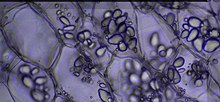
Tissues
Organisms are made of tissues. Tissues are groups of cells that work together. Plant leaves have tissues that capture light and make sugar. Most animals have muscle tissues that help them move.
When two or more tissues work together to do one thing, they make up organs.
In most Animals, there are four types of tissues:
- Epithelial tissue: This forms the borders of organs, and lines cavities or surfaces.
- Muscle tissue: Moves the body.
- Nervous tissue: Sends signals throughout the body and forms the brain and sense organs.
- Connective tissue: Holds the body together. It includes the blood, bones, and fat.

In plants, there are two types of tissues:
- Meristematic tissue: This has actively dividing cells.
- Permanent tissue: This type of tissue has developed cells. They do not divide.
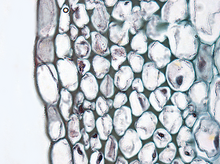
There are also two different types of permanent tissue:
- Simple permanent tissue: This type of permanent tissue has only one kind of cells. Some examples of simple permanent tissues are:
- Parenchyma: They have loosely packed cells. The cells do not have a particular function.
- Collenchyma: They have cells which have layers called pectin. They contain chlorophyll.
- Sclerenchyma: They have dead cells. Between the cells, there are layers called lignin.
- Complex permanent tissue: This type of permanent tissue contains different kinds of cells. Some examples of complex permanent tissues are:
- Xylem: This type of tissue contains mainly dead cells. They help to move water from the roots to leaves.
- Phloem: This type of tissue contains mainly living cells. They help moving food materials from leaves to other parts.
Organs


Many living things have organs. Your heart, brain, lungs, liver, and kidneys are all examples of organs.
Organs are made up of two or more tissues.
All organs have something that they do to keep you healthy. For example, the heart pumps blood, and the lungs give you air.
Organs work together in groups called organ systems.
Cambrian explosion and organ formation
The earth formed about 4.5 billion years ago. One billion years later, at the latest, there were unicellular organisms. Complex single-celled organisms, called eukaryotes, arose about 2 billion years ago. The first multicellular organisms, such as filamentous algae, jellyfish and worms, arose 1-2 billion years ago.
Around 540 million years ago, animals with complex organs such as hearts and eyes emerged. Just as the economy and way of life of people fundamentally changed in the industrial revolution in a short historical time, all animal tribes that exist today have developed in a geologically short time. Biologists speak of the Cambrian explosion. The industrial revolution was triggered by basic innovations such as the steam engine. The Cambrian explosion was also probably triggered by basic innovations that made organ formation possible. The prerequisite is that cells specialize and then migrate to the right place.
Organ systems
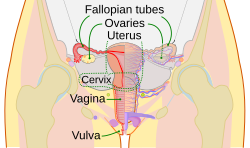
Two or more organs that work together make up an organ system.
Organ systems are found in all different kinds of living things.
Some of the organ systems found in humans include:
- Circulatory system
- Respiratory system
- Digestive system
- Endocrine system
- Reproductive system
- Urinary system
- Immune system
- Muscular system
- Skeletal system
- Integumentary system
- Nervous system

The Circulatory System
The circulatory system moves blood around your body. This blood carries nutrients and oxygen and gives it to all of the cells in the body. It also carries signals called hormones that help the body work together.
The major organ of the circulatory system is the heart, which pumps the blood. Blood goes away from the heart in tubes called arteries and comes back to the heart in tubes called veins. The smallest tubes are called capillaries.

The Respiratory System
The respiratory system is how air gets into our bodies. We breathe in and out with our lungs. The air we breathe in has something called oxygen that our cells need to work. The cells take in the oxygen and make an element called carbon dioxide, which we then breathe out.
The respiratory system works together with the circulatory system to make sure that oxygen gets to each cell of the body.
Some parts of the respiratory system are the nose, pharynx, larynx, trachea, bronchi, bronchioles, and alveoli. Here is how they all work together:
- Air comes in through the nostrils and mouth.
- Dust is removed by the hair in the nose.
- Air goes through the pharynx (which is found in the back of the mouth), through the larynx or the voice box, and down the trachea (windpipe).
- The trachea splits into two major bronchi, one for each lung.
- This further splits into smaller bronchi, then into smaller tubes called bronchioles which lead into the membranous organ called alveoli.
- This is where the oxygen goes into the blood and carbon dioxide comes out.

The Digestive System
The digestive system is how food is processed by our bodies. Food comes in through our mouth, which is broken down in our stomach. From there, the body takes the food in through the intestines, where all the nutrients are absorbed. Then the waste goes out through the anus.
The digestive system is made up of many organs. Here are some of the organs and their functions:
- Esophagus - Pushes food down into the stomach.
- Stomach - Breaks down complex sugars with acid.
- Liver - Makes a liquid called bile that breaks down fat.
- Gallbladder - Stores the bile and adds it when needed to the small intestine.
- Pancreas - Makes chemicals that break down food.
- Small intestine - Absorbs food for body.
- Large intestine - Absorbs water and salt.
- Rectum - Stores waste before it leaves the body through the anus.

The Endocrine System
As we read before, the human body is made of many, many cells. To make all these cells work together, the body sends signals through the blood called hormones that tell the cells in the body what to do. The Endocrine System is the organ system made of the organs that make hormones.
Some of the organs in the endocrine system are:
- Pineal gland
- Pituitary gland
- Thyroid gland
- Thymus
- Adrenal gland
- Pancreas
- Ovary
- Testis
How are babies made?
In humans and many other living things, there are two sexes: men and women. Babies are made when a cell called a sperm (produced by men) comes together with an egg cell or ovum (produced by women) in a process called fertilization. When the cells combine, they form a new cell, called a zygote (zy rhymes with eye; gote sounds like goat) which has all it needs to make a new man or woman. The zygote will make a baby like his mother and father.
Where do babies come from?

Babies come from their mother. To make a baby, the father must put his sperm into the mother's body. This is called having sex. The man puts his penis into the woman's vagina and the sperm cells swim into the mother's body.
Fertilization happens in the mother. The new zygote grows into a ball called a morula which will stick to the mother's womb. This ball grows into a blastula which later develops into a baby.
Nine months after fertilization, a new baby will come out of the mother's vagina in a process called childbirth.
Vocabulary words
womb - The place in a body where a baby grows.
zygote - The one cell made from a sperm cell and an egg cell that will grow into a person.
sperm - A sex cell made by a man.
egg - A sex cell made by a woman.
fertilization - When sperm and egg get together and make a zygote.

The Urinary System
The urinary system takes harmful things out of the blood and washes it out of the body. This liquid waste is called urine. Without the urinary system, bad chemicals would remain in the blood and cause serious damage to the body. The kidneys are organs in the urinary system that filter the blood and remove these chemicals. Urine is stored in a bag called the bladder and it leaves the body through a tube called the urethra.
Immune System
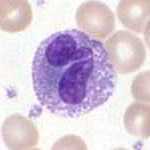
The immune system protects our bodies from disease. Cells called white blood cells found in our blood are able to kill bad things such as bacteria and viruses.
There are many different types of white blood cells. Some of them make things called antibodies that stick to things that enter our bodies, making them easy to find. Other white blood cells get rid of bacteria and stop viruses like the flu. When our immune system does not work well, we are vulnerable to diseases caused by bacteria and viruses.
Problems with the immune system include allergies; when someone has allergies, their white blood cells attack things that are not harmful to the body. When someone sneezes or their eyes water because of pollen or cat dander, it is because of the immune system's reaction to those things.
AIDS (Acquired Immunodeficiency Syndrome) is a disease caused by a virus that kills some white blood cells, which hurts the immune system and leaves our bodies vulnerable to bacteria or viruses.
Covid-19 is a virus that attacks humans. Some people have damaged immune systems after being infected with the virus.
Muscular system

The muscles of the body are what make the body move. They are made of muscle tissues.
All of the muscles of the body together make up the muscular system.
Signals from the nervous system tell the muscles when to move. The muscles are attached to the skeleton which holds them up.
The Skeletal System

The Skeletal System is made of all of the bones in the body. It protects the reproductive organs, and vital organs like the heart, lungs, and brain, and is a place for muscles to attach. Bones are a very important part of the human body. Without them, we would simply collapse, and be very unstable. They support all of our tissue and muscles, and they are very difficult to break.
The inside of the bones is called the bone marrow. This is where most blood cells are made.
Humans are born with about 300 bones. During childhood, some of these bones fuse together, so that an adult human has a little more than 200 bones.

The Integumentary System
The Integumentary System is the system of the body made up of the skin, the nails, and the hair.
Skin keeps you cool by sweating. It also protects you by keeping things out of your body. The hair on your body keeps you warm. Skin also holds nerves that we use to touch and hold and kiss. Your nails help you pick up things. The skin is the largest organ of the human body.

The Nervous System
The nervous system helps you sense the world around you. It includes the brain and the nerves as well as the senses.
The nervous system can sense changes inside and outside the body through specialized cells called receptors. This information, in the form of small electric currents, is analyzed and responses are generated in the nervous system. These responses, again in the form of small electric currents, are conveyed to the appropriate organs such as muscles or glands, at a great speed.
The Senses
Your five senses are: smell (with your nose), taste (with your tongue), touch (with your fingers, and so on), sight (with your eyes), and hearing (with your ears).

If human beings couldn't smell, they wouldn't know if their food had a bad odor. If they couldn't taste either, they might like to eat everything, or, also bad in a different way, they might not like to eat anything. If they couldn't see, it would be harder for them to find their way around and avoid danger. And if they couldn't hear, they could not communicate with each other as easily.
Kingdoms
When we look at living things we divide them up into groups and give the groups names. This is called classification.
Living things are classified into groups of different sizes. The biggest groups contain almost everything. The smallest groups have only a few types of living things in them.
The groups are, from large to small:
- Domain
- Kingdom
- Phylum
- Class
- Order
- Family
- Genus
- Species
The domains are Bacteria, Archaea, and Eukarya, but most people still find it easiest to divide things by kingdom.
The five kingdoms are:
Archaea
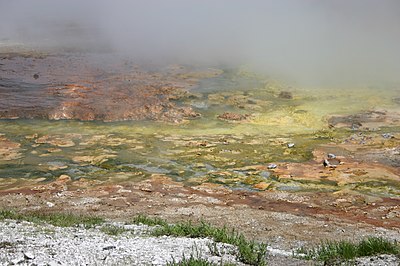
Archaea (Archaeon if there's only one) are a kingdom of creatures made up of single cells. They have been on Earth for a long, long time - longer than plants, animals, or protists. Their name means "old" in Ancient Greek. They used to be grouped in with bacteria and called "archaeabacteria", but they were later put into their own kingdom because they're so different.
Like bacteria, archaea are tiny, microscopic creatures, far too small to be seen with just your eyes. They also have no nucleus, like bacteria as well. Unlike bacteria, however, archaea can live in super hot and super cold climates, and also can't give you any nasty diseases.
Archaea can live inside of animals - some even inside of humans. Don't worry though, they can't hurt you. Many archaea live inside your intestines, feeding on matter your body can't process. Sometimes, this can even help with digestion! Some other animals use archaea inside them in other ways, too; for example, archaea living inside of termites help them process the wood they chew through.
Bacteria

Bacteria are single-celled creatures with no nucleus. They are very small. They grow all over the Earth, in the ground, in the water, and even in our bodies. Since they can be found almost everywhere on this planet, from saline areas to hot springs to human colon, they are called omnipresent.
Some bacteria can cause diseases, but most do good things like break down waste and make oxygen, fix nitrogen so that plants can absorb it and synthesise their own food.
Harmful bacteria are called gram positive bacteria.
Protists

Most protists are made of single cells. They are bigger than archaea and bacteria, and protist cells have a nucleus.
There are many different kinds of protist cells. Most live in the water, but some live in the soil or in animals. Some protists can cause diseases.
Green algae is in the kingdom Protista. These can be small single cells or very large with many cells. Sea weed is algae and is in the kingdom Protista.

Fungi
Fungi are mostly made of many cells. Fungi made of single cells are called yeasts. They are also part of a group of living things called 'Eukaryotes', just like animals and plants. We're closer to mushrooms and yeasts than you think!
Lots of people, when they see fungi, think of mushrooms, however there are lots of different types of fungi, not just mushrooms and toadstools.
Fungi are very important because they break down waste. The leaves on the bottom of a forest would get higher and higher if fungi were not there to eat it.
Fungi are also important producers of food for humans. Also, yeasts are used to make wine, beer, and bread. Some fungi are bad for our food, however, such as mould.

Plants
Plants are made of many cells. Plants are usually green. Plants make their food from the sun. They use the light, carbon dioxide, and water to make glucose (sugar). Animals, fungi, some bacteria, and some protists eat plants for food.
Plants make oxygen which humans breathe, and they take in carbon-dioxide which humans exhale (that is, breathe out). Plants make their food from the sun by photosynthesis. They also provide shade. We make our houses from plants and make clothes from plants. Most foods that we eat are plants. Without plants, animals could not survive.
What is photosynthesis?
Photosynthesis is making sugar using the energy of light.
Why are plants green?
Plants are green because they have green Chloroplasts.
But why are Chloroplasts green? Chloroplasts are green because they contain the green pigment chlorophyll in their thylakoid membranes. Chlorophyll is a pigment that absorbs red and blue light.

Animals
Animals are made of many cells. They eat things and digest them inside. Most animals can move. Only animals have brains (though not even all animals do; jellyfish, for example, do not have brains).
Animals are found all over the earth. They dig in the ground, swim in the oceans, and fly in the sky.
Humans are a type of animal. So are dogs, cats, cows, horses, frogs, fish, and so on and on.
Animals can be divided into two main groups, vertebrates and invertebrates. Vertebrates can be further divided into mammals, fish, birds, reptiles, and amphibians. Invertebrates can be divided into arthropods (like insects, spiders, and crabs), mollusks, sponges, several different kinds of worms, jellyfish — and quite a few other subgroups. There are at least thirty kinds of invertebrates, compared to the five kinds of vertebrates. Vertebrates have a backbone, while invertebrates do not.
Viruses
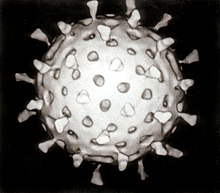
Viruses are much smaller than other living things like bacteria, so small that it would take around one hundred viruses laid end to end just to make the length of a bacterium! Viruses are not really alive. They fall in the line between living things and non-living things. They do not do all of the things that living things do. They can only make more copies of themselves when they are inside living cells.
Viruses often kill cells, and also make you ill. Lots of diseases are caused by viruses, the most famous ones are the viruses that cause the flu, colds, and Covid-19.
The End

Biology is the study of Life. Life is all around us.
It is good to learn about living things.
Know Life and know the world!
Know Life and know yourself!
Literature
License
| As of July 15, 2009 Wikibooks has moved to a dual-licensing system that supersedes the previous GFDL only licensing. In short, this means that text licensed under the GFDL only can no longer be imported to Wikibooks, retroactive to 1 November 2008. Additionally, Wikibooks text might or might not now be exportable under the GFDL depending on whether or not any content was added and not removed since July 15. |
Version 1.3, 3 November 2008 Copyright (C) 2000, 2001, 2002, 2007, 2008 Free Software Foundation, Inc. <http://fsf.org/>
Everyone is permitted to copy and distribute verbatim copies of this license document, but changing it is not allowed.
0. PREAMBLE
The purpose of this License is to make a manual, textbook, or other functional and useful document "free" in the sense of freedom: to assure everyone the effective freedom to copy and redistribute it, with or without modifying it, either commercially or noncommercially. Secondarily, this License preserves for the author and publisher a way to get credit for their work, while not being considered responsible for modifications made by others.
This License is a kind of "copyleft", which means that derivative works of the document must themselves be free in the same sense. It complements the GNU General Public License, which is a copyleft license designed for free software.
We have designed this License in order to use it for manuals for free software, because free software needs free documentation: a free program should come with manuals providing the same freedoms that the software does. But this License is not limited to software manuals; it can be used for any textual work, regardless of subject matter or whether it is published as a printed book. We recommend this License principally for works whose purpose is instruction or reference.
1. APPLICABILITY AND DEFINITIONS
This License applies to any manual or other work, in any medium, that contains a notice placed by the copyright holder saying it can be distributed under the terms of this License. Such a notice grants a world-wide, royalty-free license, unlimited in duration, to use that work under the conditions stated herein. The "Document", below, refers to any such manual or work. Any member of the public is a licensee, and is addressed as "you". You accept the license if you copy, modify or distribute the work in a way requiring permission under copyright law.
A "Modified Version" of the Document means any work containing the Document or a portion of it, either copied verbatim, or with modifications and/or translated into another language.
A "Secondary Section" is a named appendix or a front-matter section of the Document that deals exclusively with the relationship of the publishers or authors of the Document to the Document's overall subject (or to related matters) and contains nothing that could fall directly within that overall subject. (Thus, if the Document is in part a textbook of mathematics, a Secondary Section may not explain any mathematics.) The relationship could be a matter of historical connection with the subject or with related matters, or of legal, commercial, philosophical, ethical or political position regarding them.
The "Invariant Sections" are certain Secondary Sections whose titles are designated, as being those of Invariant Sections, in the notice that says that the Document is released under this License. If a section does not fit the above definition of Secondary then it is not allowed to be designated as Invariant. The Document may contain zero Invariant Sections. If the Document does not identify any Invariant Sections then there are none.
The "Cover Texts" are certain short passages of text that are listed, as Front-Cover Texts or Back-Cover Texts, in the notice that says that the Document is released under this License. A Front-Cover Text may be at most 5 words, and a Back-Cover Text may be at most 25 words.
A "Transparent" copy of the Document means a machine-readable copy, represented in a format whose specification is available to the general public, that is suitable for revising the document straightforwardly with generic text editors or (for images composed of pixels) generic paint programs or (for drawings) some widely available drawing editor, and that is suitable for input to text formatters or for automatic translation to a variety of formats suitable for input to text formatters. A copy made in an otherwise Transparent file format whose markup, or absence of markup, has been arranged to thwart or discourage subsequent modification by readers is not Transparent. An image format is not Transparent if used for any substantial amount of text. A copy that is not "Transparent" is called "Opaque".
Examples of suitable formats for Transparent copies include plain ASCII without markup, Texinfo input format, LaTeX input format, SGML or XML using a publicly available DTD, and standard-conforming simple HTML, PostScript or PDF designed for human modification. Examples of transparent image formats include PNG, XCF and JPG. Opaque formats include proprietary formats that can be read and edited only by proprietary word processors, SGML or XML for which the DTD and/or processing tools are not generally available, and the machine-generated HTML, PostScript or PDF produced by some word processors for output purposes only.
The "Title Page" means, for a printed book, the title page itself, plus such following pages as are needed to hold, legibly, the material this License requires to appear in the title page. For works in formats which do not have any title page as such, "Title Page" means the text near the most prominent appearance of the work's title, preceding the beginning of the body of the text.
The "publisher" means any person or entity that distributes copies of the Document to the public.
A section "Entitled XYZ" means a named subunit of the Document whose title either is precisely XYZ or contains XYZ in parentheses following text that translates XYZ in another language. (Here XYZ stands for a specific section name mentioned below, such as "Acknowledgements", "Dedications", "Endorsements", or "History".) To "Preserve the Title" of such a section when you modify the Document means that it remains a section "Entitled XYZ" according to this definition.
The Document may include Warranty Disclaimers next to the notice which states that this License applies to the Document. These Warranty Disclaimers are considered to be included by reference in this License, but only as regards disclaiming warranties: any other implication that these Warranty Disclaimers may have is void and has no effect on the meaning of this License.
2. VERBATIM COPYING
You may copy and distribute the Document in any medium, either commercially or noncommercially, provided that this License, the copyright notices, and the license notice saying this License applies to the Document are reproduced in all copies, and that you add no other conditions whatsoever to those of this License. You may not use technical measures to obstruct or control the reading or further copying of the copies you make or distribute. However, you may accept compensation in exchange for copies. If you distribute a large enough number of copies you must also follow the conditions in section 3.
You may also lend copies, under the same conditions stated above, and you may publicly display copies.
3. COPYING IN QUANTITY
If you publish printed copies (or copies in media that commonly have printed covers) of the Document, numbering more than 100, and the Document's license notice requires Cover Texts, you must enclose the copies in covers that carry, clearly and legibly, all these Cover Texts: Front-Cover Texts on the front cover, and Back-Cover Texts on the back cover. Both covers must also clearly and legibly identify you as the publisher of these copies. The front cover must present the full title with all words of the title equally prominent and visible. You may add other material on the covers in addition. Copying with changes limited to the covers, as long as they preserve the title of the Document and satisfy these conditions, can be treated as verbatim copying in other respects.
If the required texts for either cover are too voluminous to fit legibly, you should put the first ones listed (as many as fit reasonably) on the actual cover, and continue the rest onto adjacent pages.
If you publish or distribute Opaque copies of the Document numbering more than 100, you must either include a machine-readable Transparent copy along with each Opaque copy, or state in or with each Opaque copy a computer-network location from which the general network-using public has access to download using public-standard network protocols a complete Transparent copy of the Document, free of added material. If you use the latter option, you must take reasonably prudent steps, when you begin distribution of Opaque copies in quantity, to ensure that this Transparent copy will remain thus accessible at the stated location until at least one year after the last time you distribute an Opaque copy (directly or through your agents or retailers) of that edition to the public.
It is requested, but not required, that you contact the authors of the Document well before redistributing any large number of copies, to give them a chance to provide you with an updated version of the Document.
4. MODIFICATIONS
You may copy and distribute a Modified Version of the Document under the conditions of sections 2 and 3 above, provided that you release the Modified Version under precisely this License, with the Modified Version filling the role of the Document, thus licensing distribution and modification of the Modified Version to whoever possesses a copy of it. In addition, you must do these things in the Modified Version:
- Use in the Title Page (and on the covers, if any) a title distinct from that of the Document, and from those of previous versions (which should, if there were any, be listed in the History section of the Document). You may use the same title as a previous version if the original publisher of that version gives permission.
- List on the Title Page, as authors, one or more persons or entities responsible for authorship of the modifications in the Modified Version, together with at least five of the principal authors of the Document (all of its principal authors, if it has fewer than five), unless they release you from this requirement.
- State on the Title page the name of the publisher of the Modified Version, as the publisher.
- Preserve all the copyright notices of the Document.
- Add an appropriate copyright notice for your modifications adjacent to the other copyright notices.
- Include, immediately after the copyright notices, a license notice giving the public permission to use the Modified Version under the terms of this License, in the form shown in the Addendum below.
- Preserve in that license notice the full lists of Invariant Sections and required Cover Texts given in the Document's license notice.
- Include an unaltered copy of this License.
- Preserve the section Entitled "History", Preserve its Title, and add to it an item stating at least the title, year, new authors, and publisher of the Modified Version as given on the Title Page. If there is no section Entitled "History" in the Document, create one stating the title, year, authors, and publisher of the Document as given on its Title Page, then add an item describing the Modified Version as stated in the previous sentence.
- Preserve the network location, if any, given in the Document for public access to a Transparent copy of the Document, and likewise the network locations given in the Document for previous versions it was based on. These may be placed in the "History" section. You may omit a network location for a work that was published at least four years before the Document itself, or if the original publisher of the version it refers to gives permission.
- For any section Entitled "Acknowledgements" or "Dedications", Preserve the Title of the section, and preserve in the section all the substance and tone of each of the contributor acknowledgements and/or dedications given therein.
- Preserve all the Invariant Sections of the Document, unaltered in their text and in their titles. Section numbers or the equivalent are not considered part of the section titles.
- Delete any section Entitled "Endorsements". Such a section may not be included in the Modified version.
- Do not retitle any existing section to be Entitled "Endorsements" or to conflict in title with any Invariant Section.
- Preserve any Warranty Disclaimers.
If the Modified Version includes new front-matter sections or appendices that qualify as Secondary Sections and contain no material copied from the Document, you may at your option designate some or all of these sections as invariant. To do this, add their titles to the list of Invariant Sections in the Modified Version's license notice. These titles must be distinct from any other section titles.
You may add a section Entitled "Endorsements", provided it contains nothing but endorsements of your Modified Version by various parties—for example, statements of peer review or that the text has been approved by an organization as the authoritative definition of a standard.
You may add a passage of up to five words as a Front-Cover Text, and a passage of up to 25 words as a Back-Cover Text, to the end of the list of Cover Texts in the Modified Version. Only one passage of Front-Cover Text and one of Back-Cover Text may be added by (or through arrangements made by) any one entity. If the Document already includes a cover text for the same cover, previously added by you or by arrangement made by the same entity you are acting on behalf of, you may not add another; but you may replace the old one, on explicit permission from the previous publisher that added the old one.
The author(s) and publisher(s) of the Document do not by this License give permission to use their names for publicity for or to assert or imply endorsement of any Modified Version.
5. COMBINING DOCUMENTS
You may combine the Document with other documents released under this License, under the terms defined in section 4 above for modified versions, provided that you include in the combination all of the Invariant Sections of all of the original documents, unmodified, and list them all as Invariant Sections of your combined work in its license notice, and that you preserve all their Warranty Disclaimers.
The combined work need only contain one copy of this License, and multiple identical Invariant Sections may be replaced with a single copy. If there are multiple Invariant Sections with the same name but different contents, make the title of each such section unique by adding at the end of it, in parentheses, the name of the original author or publisher of that section if known, or else a unique number. Make the same adjustment to the section titles in the list of Invariant Sections in the license notice of the combined work.
In the combination, you must combine any sections Entitled "History" in the various original documents, forming one section Entitled "History"; likewise combine any sections Entitled "Acknowledgements", and any sections Entitled "Dedications". You must delete all sections Entitled "Endorsements".
6. COLLECTIONS OF DOCUMENTS
You may make a collection consisting of the Document and other documents released under this License, and replace the individual copies of this License in the various documents with a single copy that is included in the collection, provided that you follow the rules of this License for verbatim copying of each of the documents in all other respects.
You may extract a single document from such a collection, and distribute it individually under this License, provided you insert a copy of this License into the extracted document, and follow this License in all other respects regarding verbatim copying of that document.
7. AGGREGATION WITH INDEPENDENT WORKS
A compilation of the Document or its derivatives with other separate and independent documents or works, in or on a volume of a storage or distribution medium, is called an "aggregate" if the copyright resulting from the compilation is not used to limit the legal rights of the compilation's users beyond what the individual works permit. When the Document is included in an aggregate, this License does not apply to the other works in the aggregate which are not themselves derivative works of the Document.
If the Cover Text requirement of section 3 is applicable to these copies of the Document, then if the Document is less than one half of the entire aggregate, the Document's Cover Texts may be placed on covers that bracket the Document within the aggregate, or the electronic equivalent of covers if the Document is in electronic form. Otherwise they must appear on printed covers that bracket the whole aggregate.
8. TRANSLATION
Translation is considered a kind of modification, so you may distribute translations of the Document under the terms of section 4. Replacing Invariant Sections with translations requires special permission from their copyright holders, but you may include translations of some or all Invariant Sections in addition to the original versions of these Invariant Sections. You may include a translation of this License, and all the license notices in the Document, and any Warranty Disclaimers, provided that you also include the original English version of this License and the original versions of those notices and disclaimers. In case of a disagreement between the translation and the original version of this License or a notice or disclaimer, the original version will prevail.
If a section in the Document is Entitled "Acknowledgements", "Dedications", or "History", the requirement (section 4) to Preserve its Title (section 1) will typically require changing the actual title.
9. TERMINATION
You may not copy, modify, sublicense, or distribute the Document except as expressly provided under this License. Any attempt otherwise to copy, modify, sublicense, or distribute it is void, and will automatically terminate your rights under this License.
However, if you cease all violation of this License, then your license from a particular copyright holder is reinstated (a) provisionally, unless and until the copyright holder explicitly and finally terminates your license, and (b) permanently, if the copyright holder fails to notify you of the violation by some reasonable means prior to 60 days after the cessation.
Moreover, your license from a particular copyright holder is reinstated permanently if the copyright holder notifies you of the violation by some reasonable means, this is the first time you have received notice of violation of this License (for any work) from that copyright holder, and you cure the violation prior to 30 days after your receipt of the notice.
Termination of your rights under this section does not terminate the licenses of parties who have received copies or rights from you under this License. If your rights have been terminated and not permanently reinstated, receipt of a copy of some or all of the same material does not give you any rights to use it.
10. FUTURE REVISIONS OF THIS LICENSE
The Free Software Foundation may publish new, revised versions of the GNU Free Documentation License from time to time. Such new versions will be similar in spirit to the present version, but may differ in detail to address new problems or concerns. See http://www.gnu.org/copyleft/.
Each version of the License is given a distinguishing version number. If the Document specifies that a particular numbered version of this License "or any later version" applies to it, you have the option of following the terms and conditions either of that specified version or of any later version that has been published (not as a draft) by the Free Software Foundation. If the Document does not specify a version number of this License, you may choose any version ever published (not as a draft) by the Free Software Foundation. If the Document specifies that a proxy can decide which future versions of this License can be used, that proxy's public statement of acceptance of a version permanently authorizes you to choose that version for the Document.
11. RELICENSING
"Massive Multiauthor Collaboration Site" (or "MMC Site") means any World Wide Web server that publishes copyrightable works and also provides prominent facilities for anybody to edit those works. A public wiki that anybody can edit is an example of such a server. A "Massive Multiauthor Collaboration" (or "MMC") contained in the site means any set of copyrightable works thus published on the MMC site.
"CC-BY-SA" means the Creative Commons Attribution-Share Alike 3.0 license published by Creative Commons Corporation, a not-for-profit corporation with a principal place of business in San Francisco, California, as well as future copyleft versions of that license published by that same organization.
"Incorporate" means to publish or republish a Document, in whole or in part, as part of another Document.
An MMC is "eligible for relicensing" if it is licensed under this License, and if all works that were first published under this License somewhere other than this MMC, and subsequently incorporated in whole or in part into the MMC, (1) had no cover texts or invariant sections, and (2) were thus incorporated prior to November 1, 2008.
The operator of an MMC Site may republish an MMC contained in the site under CC-BY-SA on the same site at any time before August 1, 2009, provided the MMC is eligible for relicensing.
How to use this License for your documents
To use this License in a document you have written, include a copy of the License in the document and put the following copyright and license notices just after the title page:
- Copyright (c) YEAR YOUR NAME.
- Permission is granted to copy, distribute and/or modify this document
- under the terms of the GNU Free Documentation License, Version 1.3
- or any later version published by the Free Software Foundation;
- with no Invariant Sections, no Front-Cover Texts, and no Back-Cover Texts.
- A copy of the license is included in the section entitled "GNU
- Free Documentation License".
If you have Invariant Sections, Front-Cover Texts and Back-Cover Texts, replace the "with...Texts." line with this:
- with the Invariant Sections being LIST THEIR TITLES, with the
- Front-Cover Texts being LIST, and with the Back-Cover Texts being LIST.
If you have Invariant Sections without Cover Texts, or some other combination of the three, merge those two alternatives to suit the situation.
If your document contains nontrivial examples of program code, we recommend releasing these examples in parallel under your choice of free software license, such as the GNU General Public License, to permit their use in free software.
- ↑ Arrhenius, Gustav (2002). Short definitions of life.
- ↑ Darwin, Charles (1859). The Origin of Species retrieved by John Murray, 2009.
- ↑ Dyson, Freeman (1999). Origins of Life.
- ↑ Fröhlich, Klaus (2022). "Scientific-Philosophical Definition of Life". Science & Philosophy - Journal of Epistemology, Science and Philosophy. 10 (2): 188–205. doi:10.23756/sp.v10i2.801.
- ↑ Hennet, Remy (2002). Short definitions of life.
- ↑ Kuhn, Thomas S. (1962). The Structure of Scientific Revolutions (1st ed.). University of Chicago Press. p. 172.
- ↑ Kunin, Viktor (2000). A system of two polymerases – A model for the origin of life.
- ↑ Poppa, Radu (2004). Between Necessity and Probability: Searching for the Definition and Origin of Life. Springer Verlag.
















